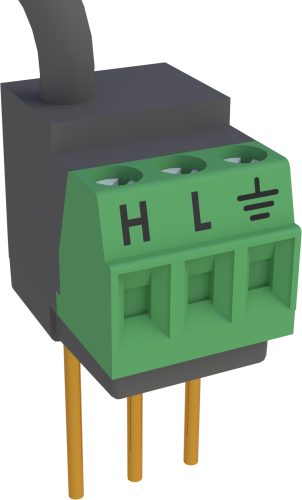
Overview
The 4WPB1K provides completion resistors that allow our dataloggers to measure a 1000 ohm platinum resistive thermometer (PRT).
Read More
Benefits and Features
- Makes accurate measurement of 1000-ohm PRTs simple
- Easy to install or remove
- Connects directly into data logger input terminals
- Compatible with most Campbell Scientific data loggers
Images



3D/CAD Files:
Detailed Description
4-Wire PRT Bridge Module Schematic
(Rf=1 kΩ for the 4WPB1K)

4WPB1K-to-Sensor Hookup

Compatibility
Please note: The following shows notable compatibility information. It is not a comprehensive list of all compatible products.
Dataloggers
| Product | Compatible | Note |
|---|---|---|
| 21X (retired) | ||
| CR10 (retired) | ||
| CR1000 (retired) | ||
| CR1000X (retired) | ||
| CR10X (retired) | ||
| CR200X (retired) | ||
| CR211X (retired) | ||
| CR216X (retired) | ||
| CR23X (retired) | ||
| CR300 (retired) | ||
| CR3000 (retired) | ||
| CR310 | ||
| CR350 | ||
| CR500 (retired) | ||
| CR5000 (retired) | ||
| CR510 (retired) | ||
| CR6 | ||
| CR800 (retired) | ||
| CR800 (retired) | ||
| CR850 (retired) | ||
| CR850 (retired) | ||
| CR9000 (retired) | ||
| CR9000X (retired) |
Measurement and Control
| Product | Compatible | Note |
|---|---|---|
| GRANITE VOLT 116 | ||
| VOLT108 |
Additional Compatibility Information
Data Logger Considerations
The 4WPB1K consumes two adjacent differential analog inputs; the first channel requires an adjacent analog ground channel to accept the "ground prong" of the 4WPB1K. Not all data logger terminal strips have this sequence on all channels, so please check your data logger's wiring panel to confirm channel assignments, especially if you plan to use multiple terminal input modules.
Newer CR10X Wiring Panels and the CR10XTCR Thermocouple Cover are deep enough to cover the data logger input channels with a terminal input module attached; older CR10TCRs are not deep enough.
Programming
When using CRBasic, the 4WPB1K is measured with the BrHalf4W Instruction followed by the PRT Instruction. When using Edlog, the 4WPB1K is measured with Instruction 9 (Full Bridge w/ Measured Compensation) followed by Instruction 16 (Temperature RTD).
Specifications
| Used With | 1 kΩ platinum resistive thermometer (PRT) |
| Dimensions | 1.5 x 1.5 x 2.7 cm (0.6 x 0.6 x 1.0 in.) for body with prongs |
| Weight | 6 g (0.2 oz) |
Current Limiting |
|
| Resistance | 10 kΩ |
| Tolerance | ±5% (@ 25°C) |
| Power Rating | 0.25 W |
Completion Resistor (bulk metal foil) |
|
| Resistance | 1 kΩ |
| Tolerance | ±0.01% (@ 25°C) |
| Maximum Temperature Coefficient | ±0.8 ppm/°C |
| Power Rating | 0.25 W (@ 70°C) |
Documents
Privacy Policy Update
We've updated our privacy policy. Learn More